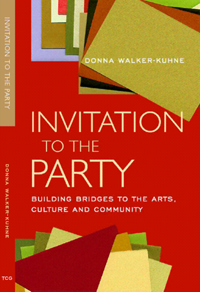Invitation to the Party
Building Bridges to the Arts, Culture and Community

2005, $16.95. New York: Theatre Communications Group, 212-609-5900.
As a coach and a longtime journalist, I know that the most powerful question is: "What did you learn?" You'll get an answer every time that is real, and relevant.
That's why Donna Walker-Kuhne's book on audience development is a must-read. The heart of the book is a series of case studies drawn from the author's own career, which began as a volunteer for a local arts center and continues as the principal of an international consulting firm.
Walker-Kuhne makes it real. She shares her challenges, her successes, and her mis-steps in an effort to help the rest of us "engage, educate and activate (primarily, but not exclusively) audiences of color." The book, she continues, is also "a guide for anyone involved in the marketing of any product who has the wisdom to understand that the world is changing, that there is now, more than ever, a specific need to embrace everyone." (p. xii)
Invitation to the Party is at its best in the chapters that tell the story of Walker-Kuhne's formative experiences with the Dance Theatre of Harlem, The Public Theater, and "Bring in 'Da Noise, Bring in 'Da Funk." Her experiences with these two institutions and the hit Broadway show exemplify the absolute necessity of leveraging community infrastructure by initiating dialogue, relationships, and partnerships.
As she attempted to cultivate new audiences of color, Walker-Kuhne learned her lessons by trial-and-error. She learned them fast, and she learned them well. As her story unfolds, it is clear that audience development requires us to:
- initiate genuine relationships
- demonstrate the value of the arts
- respond to communities on their terms
- engage in open dialogue
- build partnerships with community leaders
- empower community ownership of the arts
- remain open to feedback
- remain alert to unexpected opportunities
- identify and create the right point of entry for each audience member
- commit to sustaining a long-term process
- be gracious hosts
In addition to these strategies, Walker-Kuhne's stories contain dozens of useful grassroots tactics.
She makes clear that it's not enough anymore (if it ever was) to think: "If you build it, they will come." Audience development is not about the product. It's about the relationship, the value you add to that relationship, and the invitation to that relationship. Walker-Kuhne revamps the old adage: "If you build bridges, they will come." (p. 32; reviewer's italics)
Walker-Kuhne's strategies are rooted in a deep commitment to the arts as a form of cultural dialogue. "I firmly believe," she writes, "that the arts is the only pure vehicle we have in today's society that crosses cultural and ethnic boundaries and allows people to transcend their differences. Today, more than ever, the need to clarify misunderstandings, erase social strife and celebrate diversity is vividly apparent. It is through understanding our diversity that we can appreciate our shared humanity." (pp. xiii-xiv)
Furthermore, Walker-Kuhne refuses to polarize art and audience, instead embracing them both as mutually inclusive. She takes her cue from former Public Theater producer George C. Wolfe, who told her early on in their collaboration that "this theatre is part of a cultural institution that is as committed to serving its community as it is to putting on plays." (p. 4)
Invitation to the Party is a how-to book in the best sense of the word. Its case study approach brings theory to life and gives flesh-and-blood to statistics. For anyone new to the field, I would recommend that it be read in tandem with the Wallace Foundation's theoretical modeling of the audience development process and the Urban Institute's empirical research on how communities engage arts and culture.
For policy leaders, Walker-Kuhne's stories of herculean efforts and investments in time and personnel serve to underscore the ongoing challenge to build solid relationships between arts and communities — especially for the majority of arts organizations and independent artists without access to the resources of large institutions like The Public. Currently, every artist and arts group is left to build its own audience from scratch. The result is haphazard and grossly inefficient. Arts groups are encouraged to compete rather than to cooperate.
There is no audience-building infrastructure for the arts. Unfortunately, I don't think that national promotional campaigns, such as that of Americans for the Arts, really make a difference at the grassroots level. All audiences, like all politics, are local.
Local or regional service organizations are an ideal force for undertaking the kind of relationship-based, long-term, community-embedded audience development that Walker-Kuhne describes. But our infrastructure of service organizations has been left to languish, and appears to be making its last gasps.
In the end, Invitation to the Party challenges us to address a larger question: How can we devise cooperative conduits for audience development, as the united arts fund model is doing for fundraising?
Ann Daly, Ph.D. (www.anndaly.com) is an author, speaker, coach, and principal of Ann Daly Arts Consulting, which provides research, analysis, and advisory services to funders, arts organizations, and independent artists.>
